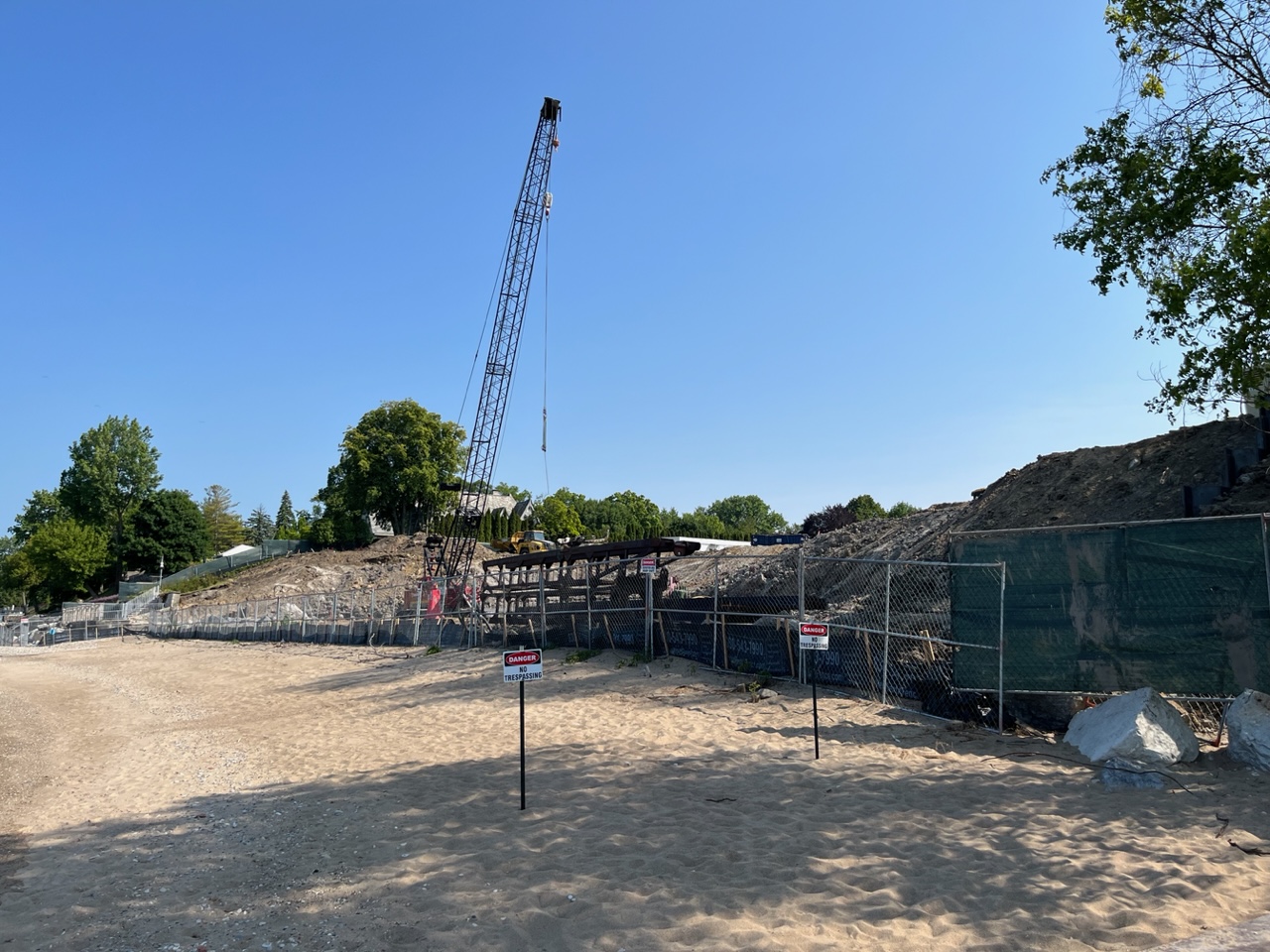
Winnetka’s bluff regulations advance to final vote — tentatively set for February
Exactly one year after the Winnetka Village Council began discussions on potential changes to its rules for shoreline protection and lakefront construction, trustees formally introduced an amendment that, if approved, would establish new guidelines for what can and cannot be done along Lake Michigan.
The unanimous introduction, which was done by a voice vote, came at the end of a three-hour meeting on Tuesday, Jan. 9, which included an hourlong discussion among trustees and commentary from opponents and proponents of the measures.
Trustees stressed to those present that, while the new measures were introduced, they are not yet officially part of the village code. To do that, trustees will need to hold a second vote, which has tentatively been scheduled for the council’s Feb. 6 meeting.
The Village Council first began exploring shoreline regulations and protections at a study session on Jan. 10, 2023, and throughout last year, continued to hold discussions and votes, one of which established a temporary pause on new lakefront construction that is in effect and set to expire in April.
The catalyst for discussions was the Ishbia family’s plans to combine four properties along the lakefront. Neighbors shared concerns about the project and how it was impacting the bluff and future development.
The Ishbia family was also at the center of a controversial land-swap agreement with the Winnetka Park District that would have combined Elder and Centennial beaches. That agreement is not currently on the table; though the park district is involved in negotiations with the Ishbia family regarding a potential $3 million donation to support the district’s lakefront plans.
At Tuesday’s meeting, David Schoon, Winnetka’s community development director, reviewed the new amendment, saying the proposed changes would redefine the demarcation line for lakefront properties from the water’s edge, which is the current practice, to the ordinary high-water benchmark as defined by the U.S. Army Corps of Engineers. That is currently 581.5 feet.
Schoon said this is a “more stable” measurement than the water’s edge.
Additionally, he said the proposed ordinance “now states that the required front-yard setback is the toe of the bluff, or 50 feet, from the lot line, whichever results are farthest from the ordinary high-water mark.”
The proposed steep slope regulations were modeled after the Village of Glencoe’s code, which creates zones for each lot that are based on each individual slope, and not a required measurement.
“Given the varying heights and steepness of slopes in Winnetka, the council found the Glencoe approach the most appropriate for our community,” Schoon said.
Regarding what types of structures and construction would be allowed in the steep slope zone, Schoon said that would include retaining wells, staircases, lifts and fences.
Boathouses would also be allowed at a maximum of 15 feet tall and 860 square feet.
Additionally, rebuilding and remodeling of existing structures would be allowed. For built structures that do not conform with the Village Code, Schoon said it may be rebuilt on the existing foundation as long as it “does not extend beyond the existing foundation and the foundation will support what is rebuilt without material adverse impact on the steep slope.”
Schoon and the trustees repeatedly stressed that there will also be a process for residents to apply for variances and special use permits to have nonconforming work done. Depending on the degree of the work, it would either be approved by the Village’s engineering director or go to the Village Council.
The majority of the public comments were from lakefront property owners and their representatives, all of whom opposed the amendment. Most gave the same or similar reasons for their opposition, citing property rights and property values.
Hal Frank, an attorney who said he represents 10 lakefront property owners, said he believes that existing Village regulations are already sufficient for bluff protection. He also suggested that parts of the proposed ordinance be deleted or clarified, while also asking the trustees to slow their process down.
“You’ve got time under the abeyance period to get it done right,” he said, later adding that his clients and other lakefront property owners “want it done correctly, and not fast.”
While most speakers opposed the ordinances, there were three proponents who spoke, including Irene Smith, who said she was representing “a large number of Winnetka residents” with her comments.
“You have taken a measured approach, you’ve studied the issues, and I believe you’ve done an excellent job,” she said.
Much of the trustees’ discussion involved clarifying and addressing some of the concerns that had been brought up during public comment.
In response, trustees indicated that they would ask Village Attorney Peter Friedman to work on the language in the proposed amendment, specifically making the variance and special use process clear for repair and renovation work within the steep slope zone.
Friedman said “we’ll make it crystal clear” that variances will be allowed.
Village President Chris Rintz also said, given the large volume of information that lakefront property owners and their representatives had provided to the board, the council would not be holding a final vote on any lakefront changes until trustees and staff had the chance to go through all of it.
He also said that, once an ordinance is introduced, it can remain tabled until the council is ready to take it up for a vote; however, trustees largely indicated they were satisfied with how the ordinance was worded, pending some clarifying changes.
Trustee Bridget Orsic said that Winnetka is one of the last lakefront communities to introduce bluff protection measures.
“We’re not creating something brand new that should be scary,” she said. “This has been going on for decades in all our neighborhood villages, and they have not suffered.”
Just before the vote, Rintz spoke at length about the process and concerns that lakefront residents have, reiterating that residents will always have the ability to appeal and apply for variances under the proposed ordinance.
“And sometimes there has to be a level of trust between the community and the people that they’ve elected to do the right thing,” he said. “We have to remember that this isn’t a bunch of people sitting up here trying to scheme ways to make life miserable for our neighbors. It’s not that at all.”
Rintz continued to emphasize trust, later adding that, when residents come to the council with variance requests, “We’re going to sit here and think about it and talk about it, but we’re going to find our way to ‘Yes.’ That’s the whole idea of this Village Council.”
The Record is a nonprofit, nonpartisan community newsroom that relies on reader support to fuel its independent local journalism.
Subscribe to The Record to fund responsible news coverage for your community.
Already a subscriber? You can make a tax-deductible donation at any time.

Peter Kaspari
Peter Kaspari is a blogger and a freelance reporter. A 10-year veteran of journalism, he has written for newspapers in both Iowa and Illinois, including spending multiple years covering crime and courts. Most recently, he served as the editor for The Lake Forest Leader. Peter is also a longtime resident of Wilmette and New Trier High School alumnus.


